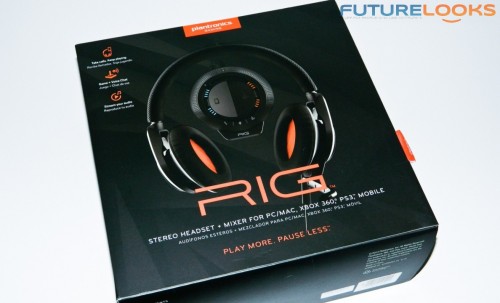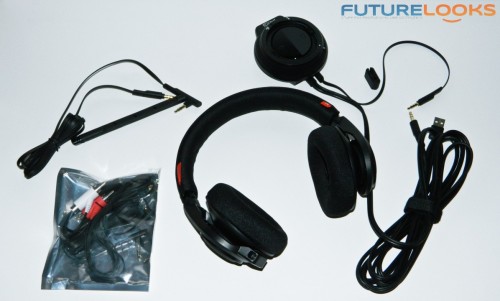Have you ever been on a game winning streak, or near an all time high score and your phone rings? Do you answer it, or keep going? Or perhaps your team really needed to get a hold of you to defend the team’s title almost last minute but you were too immersed in your other game to notice the call. While the first two are common scenarios, there are also gamers who like to game at work whether it be at the office or at home. Imagine if you could hear and talk to your incoming calls without having to take off your gaming headset. Well, imagine no longer. The Plantronics RIG Gaming Headset is exactly what you need.
Features and Specifications
The RIG, by the newly reorganized Plantronics Gaming division, provides a unique level of connectivity and management so any console or PC gamer no longer has to interrupt their game winning streak or epic pwn destined to make the record books, to answer the phone. It even supports any music player as well, negating the need to use those cheap bundled ear buds that come with most smartphones. Especially the heinous white ones that come with “fruit products”.
A couple of key questions many of you no doubt have is how does the RIG headset work and is it difficult to use. Thanks to the excellent marketing team, we got a special preview of the RIG Gaming Headset at PAX Prime 2013. Check out the video first before we get technical.
The RIG connects to any PC/MAC, Xbox 360, PS3, smartphones, and tablets. We also heard that it should support the Xbox One and PS4 but that’s still not official as both consoles are heading down different roads this time when it comes to headsets. Gamers can also connect the controllers associated with either console. With a decent sized 40mm driver in each ear cup, gamers should be able to hear everything clearly. Let’s see what’s in the box!
What’s in the Box?
Naturally, the main package contains the “puck” mixer and headset. The rest of the accessories are behind the plastic. Plantronics made sure to include most any cable needed to connect the headset to a phone or PC, or pretty much any supported device. The cables include one 5 foot 1/8 audio cable with ear mic, one 3.5mm female to dual RCA cable, one 5 foot 3.5mm inline mic cable with volume control, and one 2.5mm analog 5 foot male cable. The main USB (roughly 10 ft) and 3.5mm (14 inch) cables are permanently attached to the puck. The main USB and main audio cable stretches the RIG out to about 15 feet from the console. Of course, you don’t need that kind of distance with a desktop PC.
One note worth mentioning is that until Plantronics chances the packaging, be careful removing your RIG headset. The red-orange plastic package is pretty rigid and kind of unforgiving as you try to pull the headset out.
The RIG Up Close
For those who didn’t watch the video, there are two key components that make up the RIG: The “puck” and the headset itself. The “puck” is actually a mixer that controls the audio to any connected device and the headset. The large outside dial is the master volume. The two small sliders are volume control for phone (left) and headset (right). The bottom of the puck has three buttons. Naturally, the phone and mic buttons mute two of them. The third (right) equalizer with three presets set up to support different audio genres: Pure, Intensify, and Seismic. The black plastic center button allows you to toggle from your mobile device audio and computer audio. You can’t hear the other when one is selected. That would have kind of been neat.
The headset itself is one of the lightest worn to date most likely due to the lightweight plastics used in fabrication. The ear cup frames don’t quite flex but they don’t feel like padded steal cups on your ear either. The head band and cups are lined with rather durable cloth. However, the ear cups are made with a softer plush material for better fit.
Some minor assembly is needed so let’s get things put together before testing.
Assembly: The Wires Only Look Complicated
Starting with the gaming PC installation, it starts with the 3.5mm square shaped mic cable. The left ear cup has a square shaped port so you know where to plug the mic. Simply slide the mic in to place for a secure fit. The USB cable plugs in to any available USB port on your system. The other pre-attached 3.5mm connects to your phone. The RIG’s mixer is now the primary hub from which all audio sources converge.
The RIG is also stylishly portable if you want your tunes on the go. To make that happen, there is an extra interchangeable inline mic cable that eliminates the boom and adds inline controls. Since you phone or portable audio device is the primary audio source, the audio quality will vary depending on the device. How does it sound in both settings? That comes next.
Audio Performance
I played a variety of games and even recruited a couple extra ears to support or debunk my subjective pro-ear impressions. One of the most important attributes is that the RIG’s audio is surprisingly clear. There is no detectable line noise at all. The three EQ presets create a slightly different yet pleasant experience. Pure brings out the mid range and voices. Intensify brings out the midrange and bass significantly. Seismic increases the higher end and mid range frequencies. However, to reach the maximum volume output, you’ll need to crank it all the way up along with the OS audio settings.
The RIG’s audio rates somewhere between Corsair’s Vengeance 2000 (which is wireless) and the Steelseries Siberia V2 HyperX headset we sampled at PAX Prime 2013. So in other words, it’s pretty good.
The microphone is very sensitive so you can just hear yourself and a bit of hissing. The quick fix is to turn down mic output in Windows or your system audio software, or just mute the mic on the RIG mixer until you need it. Additionally, the desktop mic can be just a bit clunky as it doesn’t rotate, hold a position for long, and can’t be tucked away like most gaming headsets we’re used to.
You can tell if the phone or PC audio is active because the volume slider lights up, along with the fact that the toggle is depressed to that device, making it difficult to mess up a call hand off. With the phone selected, I found the phone audio isn’t any clearer per say but it is easier to hear since it passes through the puck which seems to give it a bit of a boost in volume. If you find your phone audio too loud, simply use the slider volume to bring it down. The master slider along with the individual sliders for the phone and the gaming system or PC allow you to easily normalize volume across devices so you aren’t caught off guard when you switch source.
Final Thoughts
Today’s new generation of gamers love their games, music, and social media, and crave access to it 24/7. It’s a tough target to hit but Plantronics may have zeroed in on them just right with the RIG gaming headset. It really allows you to stay mobile connected when desktop gaming which can be quite handy for the self employed (or the currently employed office worker who wants to look like he/she is hard at work). The added bonus is that the RIG will appeal to students that like big sound on the go. Most tuned ears will be pleasantly pleased by the clear quality audio, EQ presets, and audio control.
The RIG does have a couple minor issues. While the gaming mic should be a strong component, the light hiss can be a little distracting in certain games. It also doesn’t tuck away for safe storage, but it is flexible enough to take a hit. Fortunately, you have another inline mic option when you’re on the go that doesn’t have that problem.
How much will the innovative Plantronics RIG gaming headset cost you? Both the black and white model RIG can be found for $129.99 US or less. Given the price and features, the Plantronics RIG is certainly one of the most innovative gaming headsets experienced in quite some time that should keep any connected gamer pleased.
Pros
- Lightweight Design
- Long durable cabling
- Good audio quality
- Dual audio input works on multiple devices
- Common cabling all included
- Innovative RIG mixer design
Cons
- No retractable or collapsible mic
- Mic doesn’t hold placement well
- Has some inline mic hissing
Overall Rating: 9.0 / 10.0
Help Us Improve Our Reviews By Leaving a Comment Below!



![[HD] PAX Prime 2013 Part 2 - Covering NVIDIA, Plantronics, StinkyFoot Board, and CORSAIR](https://i.ytimg.com/vi/gNxXXCTVCbU/hqdefault.jpg)
